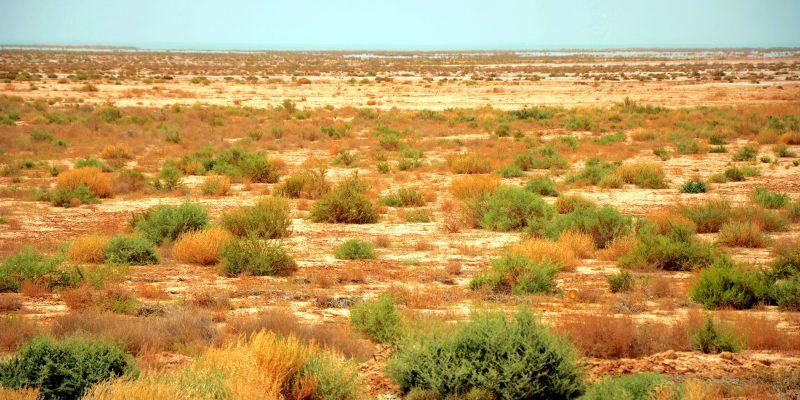Humidity Is the Real Heat-Wave Threat
As the world's climate warms, scientists warn that water-sodden air can greatly intensify the effects of extreme heat. Bandar Mahshahr, Iran. (Alireza Javaheri / Wikimedia Commons)
Bandar Mahshahr, Iran. (Alireza Javaheri / Wikimedia Commons)
When the mercury climbs to extreme levels, it’s the dangerous humidity produced by heat reacting with water-sodden air that can spell death, not just the heat alone.
US researchers have warned yet again of the need to beware the risks of this combination. With fierce heat waves expected to become more common as the climate warms, they say humidity can greatly intensify the effects of the heat by itself.
They report in the journal Environmental Research Letters that during this century the drastic effects of high humidity in many areas will increase significantly. At times, they may overtake people’s ability to work outdoors or, in some cases, even to survive.
Health and economies would suffer, especially in regions where people work outside and have little access to air conditioning. Potentially affected regions include large swathes of the already muggy south-eastern United States; the Amazon; western and central Africa; southern areas of the Middle East, including the Arabian peninsula; northern India; and eastern China.
“The conditions we’re talking about basically never occur now – people in most places have never experienced them”, said lead author Ethan Coffel, a graduate student at Columbia University’s Lamont-Doherty Earth Observatory. “But they’re projected to occur close to the end of the century.”
The warming climate is projected to make many now-dry areas dryer, in part by changing precipitation patterns. But, as global temperatures rise, the atmosphere can hold more water vapour. That means chronically humid areas may only get more humid.
Muggy heat is more oppressive than the “dry” kind, because humans and other mammals cool down by sweating; sweat evaporates off the skin into the air, taking the excess heat with it. That works well in a desert. But when the air is already laden with moisture, evaporation off the skin slows down, and eventually becomes impossible.
When this cooling process stops, a creature’s core body temperature rises beyond the narrow tolerable range. Without air conditioning, organs strain and then start to fail, leading to lethargy, sickness and possibly death.
Using global climate models, the researchers mapped current and projected future “wet-bulb” temperatures, which reflect the combined effects of heat and humidity (the measurement is made by draping a water-saturated cloth over the bulb of a conventional thermometer; it does not correspond directly to air temperature alone).
The study found that by the 2070s, high wet-bulb readings that now occur perhaps only once a year could stretch to 100 to 250 days annually in some parts of the tropics. In the south-east US, wet-bulb temperatures now sometimes reach 29 or 30°C; by the 2070s or 2080s, such weather could occur 25 to 40 days each year, say the researchers.
Laboratory experiments have shown wet-bulb readings of 32°C are the threshold beyond which many people would have trouble functioning outside. This level is rarely reached anywhere today.
But the study projects that in 50 or 60 years the limit could be reached one or two days a year in the US southeast, and three to five days in parts of South America, Africa, India and China. Worldwide, hundreds of millions of people would suffer.
The hardest-hit area in terms of human impact, the researchers say, will probably be densely populated north-eastern India.
“Lots of people would crumble well before you reach wet-bulb temperatures of 32°C, or anything close”, said co-author Radley Horton, a climate scientist at Lamont-Doherty. “They’d run into terrible problems.”
The study projects that some parts of the southern Middle East and northern India may even hit 35 wet-bulb degrees Celsius by late this century – equal to the human skin temperature, and the theoretical limit at which people will die within hours without artificial cooling.
Using a related combined heat/humidity measure, the so-called heat index, this would be the equivalent of nearly 170° Fahrenheit of “dry” heat. But the heat index, invented in the 1970s to measure the real feel of moist summer weather, actually ends at 136; anything above that is literally off the chart.
On the bright side, the paper says that if nations can substantially cut greenhouse gas emissions in the next few decades, the worst effects could be avoided.
Only a few weather events like those projected have ever been recorded. The most recent was in Iran’s Bandar Mahshahr in July 2015. That day the “dry” air temperature alone was 115°; saturated with moisture, the air’s wet bulb reading neared the 35 °C fatal limit, translating to a heat index of 165°F.
Bandar Mahshahr’s infrastructure is good and electricity cheap, so residents adapted by staying in air-conditioned buildings and vehicles, and showering after brief excursions outside. But this is not an option in other vulnerable places, where many people cannot afford such remedies.
“It’s not just about the heat, or the number of people. It’s about how many people are poor, how many are old, who has to go outside to work, who has air conditioning”, said the study co-author Alex deSherbinin of Columbia’s Center for International Earth Science Information Network (CIESIN).
He said that even if the weather does not kill people outright or stop all activity, the necessity of working on farms or elsewhere outdoors in such conditions can bring chronic kidney problems and other damaging health effects.
Other researchers have sounded the alarm about the risks dangerous humidity levels can pose. A 2015 study said parts of the Gulf region, where Bandar Mahshahr lies, could, on present trends, become uninhabitable for humans by 2100.
The following year another study extended the warning to include North Africa. Earlier this year sports chiefs even reported that humidity could affect the behaviour of cricket balls.
Climate scientist Steven Sherwood of the University of New South Wales, who proposed the 35°C survivability limit, said he was sceptical that this threshold could be reached as soon as the researchers say. All the same, he said, “the basic point stands.”
Unless greenhouse emissions are cut, “we move toward a world where heat stress is a vastly greater problem than it has been in the rest of human history. The effects will fall hardest on hot and humid regions.”
Your support matters…Independent journalism is under threat and overshadowed by heavily funded mainstream media.
You can help level the playing field. Become a member.
Your tax-deductible contribution keeps us digging beneath the headlines to give you thought-provoking, investigative reporting and analysis that unearths what's really happening- without compromise.
Give today to support our courageous, independent journalists.








You need to be a supporter to comment.
There are currently no responses to this article.
Be the first to respond.